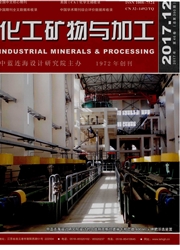

 中文摘要:
中文摘要:
钾长石-磷石膏-碳体系共焙烧可以同时实现提钾、固废资源化利用以及矿化固定CO2多重效益。本文采用两种共焙烧温度制度,即随炉升温与定温加料,对体系提钾率、脱硫率以及矿化率的影响进行了研究。结果表明,随炉升温时,硫酸钙炭热还原脱硫反应发生在800℃,至900℃时接近完成,而硫酸钙与钾长石转化反应尚未显著发生,继续升温时用于转化反应的硫酸钙已经很少。因此,这种温度制度脱硫率高,900℃时为65%;提钾率低,最高仅为11%;高的脱硫率产生了更多易于矿化的Ca2SiO4,故矿化率高,最高为79%。定温加料时,硫酸钙将同时发生炭热还原和钾长石转化反应,因此,脱硫率低,矿化率仅30%,而提钾率相对较高,最高可达47%。
 英文摘要:
英文摘要:
Multiple benefits of extracting potassium, solid waste resource utilization and CO2 mineralization could be realized by calcining in the system of potassium feldspar-phosphogypsum- carbon. Effects of two kinds of calcining temperature schedules, namely heating with the furnace temperature and charging at con- stant temperature on extracting potassium rate, desulfuration rate and mineralization rate were studied. Results show that while heating with the furnace temperature, the carbothermic re duction and desulfurization reaction of calcium sulfate takes place at 800 ℃ and almost completed at 900 ℃. Simultaneously, the transformation reaction of calcium sulfate and potassium feldspar has not yet carried on significantly due to less calcium sulfate. Therefore, this schedule has a high desulfurization rate being 65% at 900 ℃, low potassium rate (11%) and high mineraliza- tion rate (79%) because high desulfurization rate could produce more Ca2 SiO4 liable to be mineralized. When charging at constant temperature, carbothermic reduction and transformation reaction will happen simultaneously. Therefore, the desulfurization rate is low and the mineralization rate is only 30%, but the extracting potassium rate is relatively high, up to 47%.
 同期刊论文项目
同期刊论文项目
 同项目期刊论文
同项目期刊论文
 期刊信息
期刊信息
